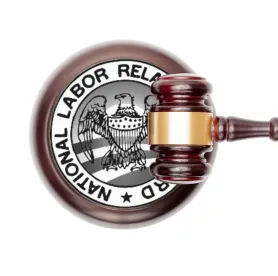On August 28, 2023, the National Labor Relations Board (“NLRB” or the “Board”) issued its decision in Intertape Polymer Corp., 372 NLRB No. 133 (2023) clarifying the standard by which the General Counsel satisfies her initial burden of persuasion in cases involving mixed motives for adverse employment actions. Specifically, the Board revisited and clarified Tschiggfrie Properties, 368 NLRB No. 120 (2019), expressly stating that Tschiggfrie correctly articulated the proper standard.
Background
For over 40 years, the Board has applied the burden-shifting framework articulated in Wright Line, 251 NLRB 1083 (1980) to allegations of discrimination. Wright Line established a two-part causation test to determine whether an employer was discriminatorily motivated by union animus when it took adverse employment action against an employee.
-
First, the General Counsel bears the initial burden of showing that some activity protected by the National Labor Relations Act (“NLRA”) was a motivating factor in the employer’s decision.
-
The elements required to sustain the General Counsel’s burden have been summarized as: (1) protected activity by the employee, (2) employer knowledge of that protected activity, and (3) employer animus against union or other protected activity. The General Counsel may satisfy her burden through direct and/or circumstantial evidence.
-
Second, if the General Counsel satisfies her prima facie case, the burden shifts to the employer to demonstrate that it would have taken the same action in the absence of any protected activity.
Some administrative law judges (“ALJ”) have erroneously added a fourth element to the General Counsel’s initial burden: a showing of some nexus or connection between the employee’s specific protected activity and the adverse employment action. In Libertyville Toyota, 360 NLRB 1298 (2014), the Board rejected the ALJ’s attempt to apply this fourth element and held that Wright Line does not require “some additional showing of particularized motivating animus towards the employee’s own protected activity or to further demonstrate some additional, undefined ‘nexus’ between the employee’s protected activity and the adverse action.” Libertyville Toyota created confusion, as some ALJs interpreted the language to mean the General Counsel need only show some general union animus to satisfy her initial burden.
The Board addressed this confusion in Tschiggfrie Properties and explained that the General Counsel must establish some connection between the employee’s protected activity and the employer’s adverse action, whether by direct evidence or circumstantial evidence based on the record as a whole, and mere evidence of general union animus may not suffice.
The Board’s Clarification of the Standard
In Intertape Polymer, the Board majority rejected the General Counsel’s position that Tschiggfrie Properties imposed an additional requirement that the General Counsel must show “animus to a particular discriminatee’s protected activities.” Instead, the majority held that Tschiggfrie Properties correctly applied the Wright Line standard but created confusion by unnecessarily overruling cases like Libertyville Toyota. The majority explained that the General Counsel satisfies her initial burden by presenting evidence that permits an inference that the protected activity was a motivating factor in the allegedly unlawful employment action. Some cases may require a particularized showing of discriminatory motivation, but in other cases a showing of general union animus may be sufficient.
Member Kaplan’s Concurrence
In a concurring opinion, Member Kaplan asserted that revisiting Tschiggfrie Properties was unnecessary and improper. At the outset, he observed that the majority claimed Tschiggfrie Properties created considerable confusion yet failed to cite any cases as evidence of such confusion. He contended that the Tschiggfrie Properties clarification was, indeed, necessary as “there must be some analytical outer limit to the generality of animus evidence.” Because the majority agreed that Tschiggfrie Properties did not alter Wright Line and properly applied the relevant standard, Member Kaplan argued that revisiting the decision to address its overruling of Libertyville Toyota and similar cases went beyond the scope of the case at hand and should be considered non-precedential dicta.
Takeaways
Substantively, Intertape Polymer should have little impact on employers defending allegations of unlawful discrimination. The decision does not ease the General Counsel’s initial burden in mixed motive cases. As the majority observed, the Board and courts have long held that animus and a causal connection may be inferred from circumstantial evidence based on the record as a whole. “The General Counsel need not produce evidence of particularized animus toward an employee’s own protected activity or of a causal nexus between the protected activity and the adverse action to meet her burden.” Employers considering disciplining any unionized employees, especially those active in the union, should first consult with counsel.
As a final note, it is worth observing that the Board rejected the General Counsel’s request to overrule Electrolux Home Products, 368 NLRB No. 34 (2019), a Trump-era decision which held that finding an employer’s proffered reason for adverse employment action to be pretextual does not automatically satisfy the General Counsel’s initial burden under Wright Line (discussed more fully here). The Board determined that there was no need to revisit Electrolux because there was additional evidence of animus to support the General Counsel’s case in Intertape Polymer, thoughMember Wilcox disagreed and stated that she would overrule Electrolux. Accordingly, General Counsel Abruzzo may well seek another opportunity to overturn Electrolux.





 />i
/>i

